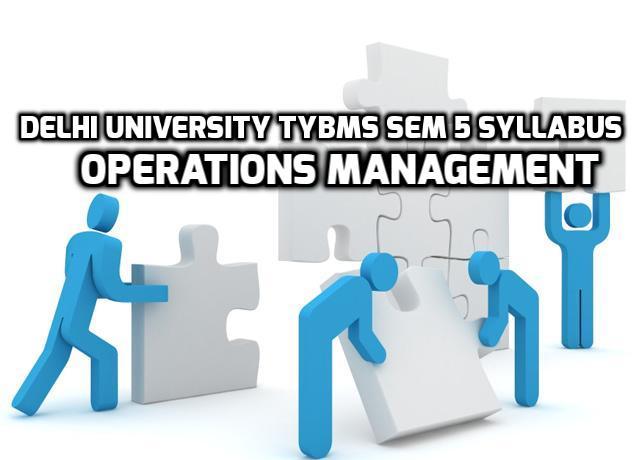Operations Management is an area of business management which deals with overseeing, designing, and controlling the production process and redesigning the business operations in terms of production of goods and services. Operations Management is concerned with managing and directing the physical and / or technical functions of an organization.
Operations Management is a subject of Delhi University Undergraduate programme in Bachelor of Management Studies. Operations Management subject aims to make DU BMS students understand the production and operation function and familiarize them with the techniques of planning and control.
Here we present Delhi University TYBMS Sem 5 Syllabus: Operations Management:
Unit 1 – 6 lectures
- Operations Management – An Introduction
- Introduction to Production and Operations Management
- Definition, need, responsibilities, key decisions of OM,
- Goods vs services
- Operations as a key functional area in an organization
- Operation Strategies – Definition, relevance
- Strategy formulation process
- Order qualifying and order wining attribute
- Definition of lean production
- Lean demand pull logic
- Waste in operations
- Elements that address elimination of waste
- 2 card kanban production control system
Unit 2 – 10 lectures
- Forecasting and scheduling
- Forecasting – definition, types
- Qualitative – grass roots, market research and Delphi method
- Quantitative approach – simple moving average method, weighted moving average and single exponential smoothing method
- Forecast error
- Mean absolute deviation (MAD)
- Scheduling – operation scheduling
- Goals of short term scheduling
- Job sequencing (first cum first serve FCFS)
- Shortest processing time (SPT)
- Earlier due date (EDD)
- Longest processing time (LPT)
- Critical ration (CR) and Johnson’s rule on two machines
- Gantt charts
Unit 3 – 20 lectures
- Planning techniques
- Aggregate planning – definition, nature, strategies
- Methods of aggregate planning – level plan, chase plan and mixed plan, keeping in mind demand, workforce and average inventory.
- Capacity planning –definition, measures of capacity – input and output
- Types of planning over time horizon
- Decision trees analysis
- Queuing and inventory models
- Elementary queuing theory models
- Poisson – exponential single server model with infinite population
- M/M/1, M/M/C,
- Inventory management – economic order quantity with finite and infinite supply
Unit 4 – 8 lectures
- Operations and services design
- Process selection – definition,
- Characteristics that influence the choice of alternative processes – volume and variety
- Type of processes – job shop, batch, mass and continuous, product-process design
- Matrix and services design matrix
- Technology issues in process design
- Flexible manufacturing systems (FMS)
- Computer integrated manufacturing (CIM)
- Layout decision
- Layout planning – benefits of good layout, importance, different types of layouts
- Process, product, group technology and fixed position layout
- Assembly line balancing by using Longest Operating Time (LOT) rule
- Location decisions and models
- Facility location –objective, factors that influence location decision
- Location evaluation methods
- Factor rating method
Unit 5 – 12 lectures
- Maintenance management and quality control
- Maintenance management – need
- Equipment life cycle – bathtub curve
- Measures for maintenance performance
- Mean time before failure MTBF
- Mean time to repair MTTR and availability
- Reliability – definition and function of series and parallel
- Statistical quality control – variations in process – common and assignable causes
- Variable measures – mean and range chart
- Attribute measures – proportion of defects and number of defects using control tables, control charts, single sampling plan
- OC curve
- Acceptance sampling
Text books and References:
- Operations Management Theory and Practice – second edition – Mahadevan B (2006)
- Production and Operations Management – third edition – S.N. Charry (2000)
- Fundamentals of Applied Statistics – fourth edition – S.C. Gupta and V.K. Kapoor (2010)
- Production and Operations Management -8th edition – Heizer Jay and Render Barry (2005)
- Production and Operation management, manufacturing and services – Chase R.B., Aquilano N.J., Jacobs F.R. and Agarwal N. (2006)
- Reliability Engineering and Life Testing – V.N.A. Naikan (2011)




50 Comments